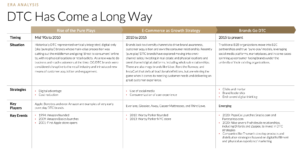Chances are in the past 12 months you’ve purchased something online. Maybe even a lot of things online. (I generally don’t like to make assumptions but I feel safe on this one.) And chances are at least one of your purchases were from a brand that only sells online; had great prices; offered flexible payment terms; offered some kind of perk in exchange for creating an account with them. Assuming all of this is true it would mean as a customer, you had a first-hand, direct-to-consumer experience. Congratulations!
But what’s the big deal? You just bought something, right? As a consumer, if you had an easy, frictionless experience buying from this DTC brand, it went off exactly as they intended. If you sit on the other side of the equation though and are leading exploration or commercialization of a DTC brand, you know the frictionless experience was a result of months, maybe years, of strategy, research and planning that were far from frictionless. Today’s DTC businesses are a far cry from pure plays of the late 90s. So what does direct-to-consumer look like in 2021?
This blog series will explore What direct-to-consumer looks like today, Why it can be an important growth strategy for traditional B2B organizations, and How to start planning a modern DTC play.
Let’s start with a basic operational definition.
Direct-to-consumer (DTC) refers to selling products directly to customers, bypassing any third-party retailers, wholesalers, or any other middlemen.
Increasingly, DTC means thinking ‘digital-first’ across product development, marketing and distribution.
That second part hints at the evolution of DTC but I think Henry McNamara, Partner at Great Oaks Venture Capital, captures the sentiment best:
“A lot of people think a [DTC] brand is just a landing page and a logo. But in our experience, [with] the most successful brands we’ve seen, it’s really a promise, and trust that you build with customers so that they can depend on everything from the interaction they have with a customer service rep, to the product that shows up at their door”
So What?
The direct-to-consumer explosion isn’t slowing down as evidenced by the continued emergence of new brands and tremendous growth of brands in existing categories.
For emerging brands, the focus is on authenticity, product differentiation, and the right mix of digital distribution channels.
For existing brands, especially traditionally B2B organizations, there are more opportunities than ever to capitalize on the influx of traffic to digital properties and drive growth by driving awareness and distribution through DTC channels.
Regardless of brand maturity, reinvention and innovation across organization, people, process, and technologies will be key in going direct-to-consumer and providing experience-driven commerce, as customer expectations shift and increase at an exponential rate.

DTC Era Analysis
While technology capabilities and customer expectations have forced the definition of DTC to evolve over time, basic tenets like cutting out the middleman and focusing on digital channels remain. What’s new is a “digital-first” and experience-driven mindset across product, marketing and distribution to meet customers where they are.
Part 2 of “The Return of Direct-to-Consumer” series will provide examples of DTC brands that have embraced experience-driven commerce and are winning big because of it, and those that aren’t quite living up to the DTC brand promise – a cautionary tale.

